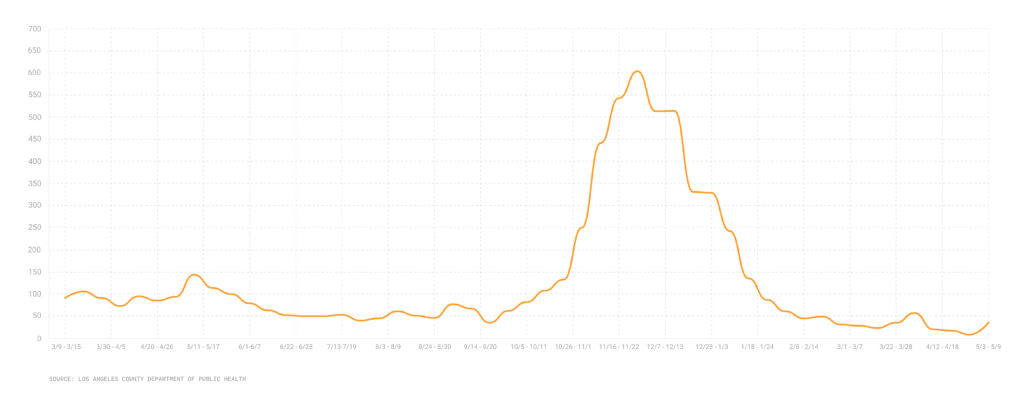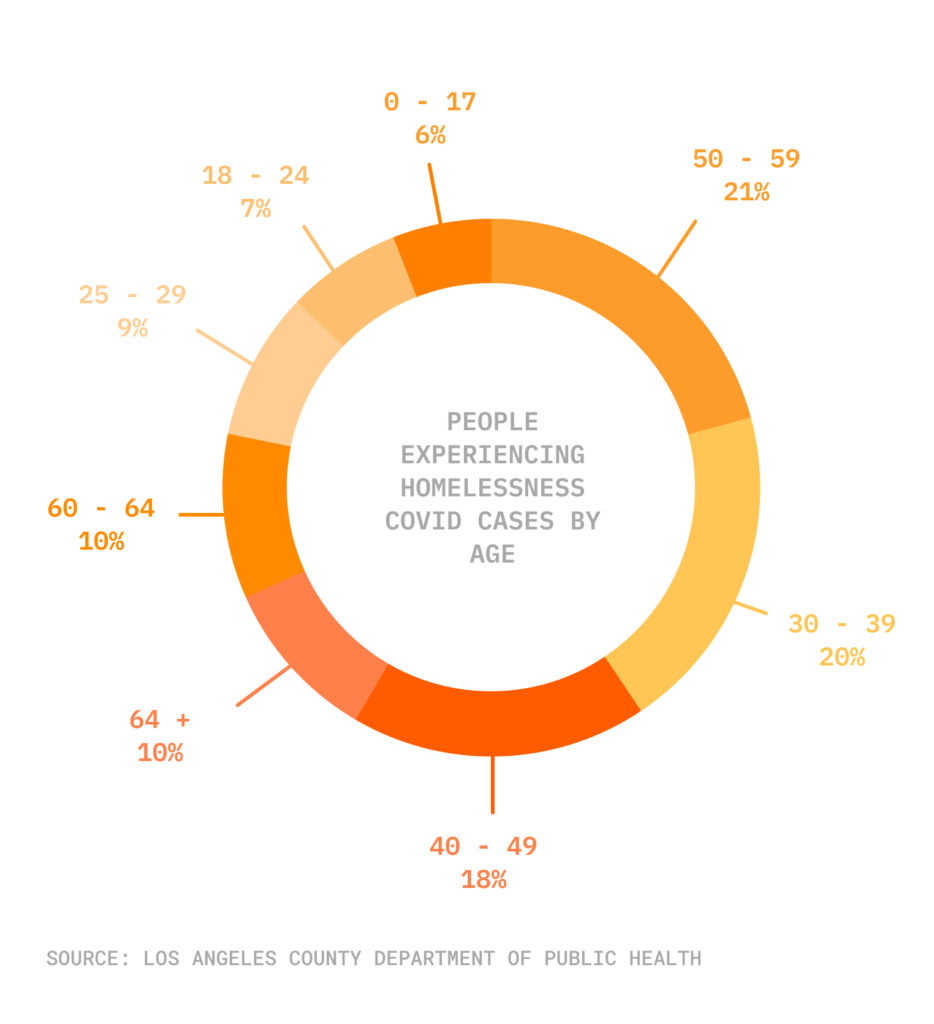COVID cases among people experiencing homelessness fall sharply

COVID-19 numbers in Los Angeles have been falling for months, and recently figures for new cases and hospitalizations have reached levels not seen since the earliest days of the pandemic. The positive news goes beyond the spate of business reopenings: Some of the region’s most vulnerable residents are also faring better.
In a recent one-week period, 36 new coronavirus cases were diagnosed among people experiencing homelessness. That is down from a high of 604 weekly cases in late December, according to a May 12 statement from the Los Angeles County Department of Public Health.
Weekly new COVID-19 cases in Los Angeles among people experiencing homelessness, March 2020-May 2021

As of May 16, there had been 7,099 confirmed COVID-19 cases among people experiencing homelessness in the region, according to Department of Public Health data. A total of 208 people experiencing homelessness have died.
Ninety-four people experiencing homelessness who passed away from COVID-19 were living in some type of shelter, and 69 were unsheltered, according to department data (the shelter status of 45 individuals who died is unknown). County tracking also reveals that 972 shelter staff and volunteers have contracted COVID-19; there have been four deaths.
[Get COVID-19, crime and other stats about where you live with the Crosstown Neighborhood Newsletter]
At the onset of the pandemic in March 2020 there were heightened concerns that the coronavirus would course through a community that often lacks ready hand-washing and sanitary facilities. The Centers for Disease Control recommended not shutting down tent encampments so as not to displace individuals and increase contact. Los Angeles leaders largely followed those recommendations.
Steve Fiechter, senior director of the L.A. Metro Program at service provider People Assisting the Homeless, known as PATH, said these factors helped keep numbers relatively low for many months. It was not until mid-November that there were more than 200 new weekly cases among people experiencing homelessness.
“Toward the beginning of the pandemic, folks experiencing homelessness—because they were isolated from the rest of the community in many regards—weren’t immediately as affected, because the pandemic entered through people who have means to travel and to connect,” Fiechter said. “Because they are typically health-compromised to begin with and also often frail and elderly, there are other challenges they have that make them more vulnerable.”
Fiechter said that occupancy in PATH’s interim housing facilities was decreased to about 50%-60% of capacity to maintain social distancing. Other shelters took similar steps.
Providing resources
Although the number of tents on the streets has swelled during the pandemic, Fiechter said that there has been an increase in interim housing availability through initiatives such as Project Roomkey, which utilizes underused hotel space to temporarily house people experiencing homelessness, and Project Homekey, which turns hotels into permanent housing. The trend could continue, as last week Gov. Gavin Newsom announced that $12 billion from the state would be set aside to address homelessness.
John Maceri, chief executive of service provider The People Concern, said one of the greatest challenges people experiencing homelessness have faced during the pandemic is access to public amenities. He pointed to shuttered libraries, which traditionally were a place to use the Internet or charge cell phones.
“That was all not available to them,” Maceri said. He added that resources such as stores and coffee shops “where people could potentially use the restrooms were closed, so meeting their basic needs was very limited.”
Among people experiencing homelessness who tested positive for COVID-19 in L.A. County, 66% were men and 33% were women, roughly equivalent to the gender breakdown of homeless individuals in the county.
Forty-four percent of people experiencing homelessness were Hispanic or Latino, and 25% were Black.
Approximately 20% of the coronavirus cases among people experiencing homelessness were 60 or older, while 22% were under the age of 30.

As vaccine distribution has increased, health and elected officials have sought to ensure that access is provided to people experiencing homelessness, sometimes through mobile clinics. According to the Department of Public Health, 115 providers across the county have administered 21,550 vaccine doses to people experiencing homelessness. At least 3,286 of those vaccinated received second doses.
In some cases the Johnson & Johnson vaccine, a single-shot regimen, has been prioritized for people experiencing homelessness to ease the process of coordinating a second dose.
“Most of those vaccinations are being done on the street or in pop-up sites where the outreach teams are connecting people,” said Maceri.
Maceri believes that the collaboration between nonprofits, service providers and the Department of Public Health has allowed for more effective efforts to contain the spread of the coronavirus and provide vaccines to people experiencing homelessness.
How We Did It: We examined publicly available data from the Los Angeles County Department of Public Health from March 15, 2020-May 12, 2021.
Interested in our data? Check out the Crosstown coronavirus interactive map or email us at askus@xtown.la.






